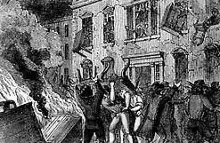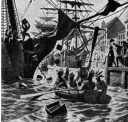The Sons of Liberty
The Sons of Liberty didn't wait to take action. The first large-scale public action took place on August 14, 1765, 10 weeks before the Stamp Act was scheduled to go into effect. Mackintosh organized a crowd to appear in the South End and hang from the Liberty Tree effigies of Andrew Oliver, the stamp master, and Lord Bute, one of the favorites of King George III. An effigy was commonly a straw figure made to resemble the target of scorn or derision. Protesters commonly hung an effigy from a tree and then burned the straw figure, those somewhat violent actions symbolically taking the place of actual violence against the person. This the mob did, hanging the figures in the morning and then, at the end of the day, taking them to nearby Fort Hill and setting them alight. The only hint of violence took place just before the burning, when the crowd took the effigies to the dock, to a building that was thought to be the eventual home of the stamp office, and demolished it. 
Lt. Gov. Thomas Hutchinson attempted to make the crowd disperse. This angered some members of the effigy mob, who went to Oliver's house and vandalized it. The following night, a large crowd gathered outside Hutchinson's house. They insisted that Hutchinson report back to London the colonists' strong desire that the Stamp Act not become law. Hutchinson said that he would do nothing of the kind. The crowd returned several days later and vandalized not only Hutchinson's house but also the homes of two other British officials. The damage to Hutchinson's house was particularly severe: the mob demolished his furniture, tore out windows from the walls, ripped tiles from the floors, and demolished the cupola on the roof; in addition, they ripped up his collection of books and papers and walked off with jewelry and many kinds of valuables and the contents of his wine cellar. 
The Sons of Liberty also embraced a somewhat violent method of protest known as tarring and feathering. As the name suggests, this involved removing an official's clothes, either above the waist or in their entirety, and then covering him in hot tar. For the next step, the belligerents would either throw feathers at the tarred man or roll him on the ground in a pile of feathers. The goal was for the feathers to stick to the tar. This particular kind of punishment was a very old one, dating to medieval England and the reign of King Richard I. It was a painful and public form of humiliation. 
An incensed Parliament introduced the Stamp Act as law on November 1, 1765. Protests were widespread, if less violent. The colonists formed the Stamp Act Congress, which produced the Declaration of Rights and Grievances. Boycotts ensued. The law was flouted. Eventually, Parliament got the message and repealed the the Stamp Act, on March 17, 1766. The Sons of Liberty organized celebrations and then officially disbanded. For a number of years, they would gather at the Liberty Tree in mid-August to commemorate the anniversary of the events of August 14–15. Parliament had not passed its last tax law, however. In 1767, the colonists were confronted with the Townshend Acts, a series of new taxes on various things imported into the colonies. Among them were china, glass, lead, paint, paper, and tea.A reformed and reinvigorated Sons of Liberty organized protests against the new taxes and engineered a boycott on British goods. Also taking part in the boycott were sympathetic women, members of the Daughters of Liberty. This time around, Sons of Liberty meetings took place in the daytime and in public places. The boycott was particularly effective, and Parliament in 1770 repealed the Townshend Acts–with the exception of the tax on tea. 
One particularly violent action taken by the Sons of Liberty was the burning of the British ship HMS Gaspee, in Rhode Island on June 10, 1772. The ship's crew were involved in customs collection and had run aground while chasing a ship believed to be smuggling. A group of men, many likely members of the Sons of Liberty, rowed out to the ship and set it alight. The crew resisted, and a British officer was wounded in the struggle. 
The most famous action taken by the Sons of Liberty came to be known as the Boston Tea Party. Parliament had kept the tax on tea and added to its relevance by passing the Tea Act in 1773, which gave a near monopoly to the British East India Company. An incensed crowd stormed aboard three British ships on Dec. 16, 1773 and dumped hundreds of crates of tea into Boston Harbor. The group continued to increase its membership and its visibility and continued to protest against what its members saw as oppression by the British government. Agitation by the Sons of Liberty helped convince many people that historic steps were needed to stop what was happening. |
|
Social Studies for Kids
copyright 2002–2024
David White




